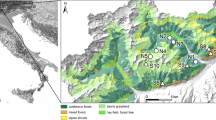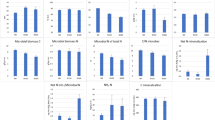Abstract
Contents of organic sulfur, sulfate and the inorganic cations K+, Ca2+, Mg2+, Mn2+ and Na+ were compared in needles of three conifer species differing in tolerance to chronic SO2 immissions. Sulfate and organic sulfur compounds were also measured in bark and wood. Field material was collected from Norway Spruce (Picea abies (L.) Karst.), Colorado Spruce (Picea pungens Engelm.) and Scots Pine (Pinus sylvestris L.) at sites where the SO2 concentration in air was high, and at another site where it was low. In general, sulfate contents were higher but cation contents lower at the sites where SO2 concentrations were high than where they were low. Up to 114mmol · (kg DW)−1 sulfate was measured in fouryear-old needles of Norway Spruce from the Erzgebirge (annual mean of SO2 in air 32 nl · 1−1). Sulfate accumulation in this SO2-sensitive conifer increased with SO2 concentration in ambient air and with needle age, indicating that the main part of the sulfate resulted from the oxidative detoxification of SO2. Loss of inorganic cations from ageing needles was reduced, or cation levels even increased, with increasing needle age, while sulfate accumulated. Apparently, cations served as counter-ions for sulfate, which is sequestered in the vacuoles. Individual trees differed in regard to the nature of cations which accumulated with sulfate. Calcium, potassium and magnesium were the dominating cations. Sodium levels were very low. Needles of the SO2-tolerant conifers Colorado Spruce and Scots Pine growing next to Norway Spruce in the Erzgebirge did not accumulate, or accumulated less, sulfate with increasing needle age as compared to needles of Norway Spruce. However, somewhat more sulfate was found in the bark of the SO2-tolerant species than in the bark of Norway Spruce. Scots Pine contained distinctly more sulfate in the wood than the other conifers. Since accumulation of organic sulfur compounds could not be observed with increasing needle age, or in bark and wood, reduction does not appear to play a major role in the detoxification of SO2 by the investigated species. Physiological mechanisms permitting Colorado Spruce and Scots Pine to avoid the sulfate accumulation in the needles and the accompanying sequestration of cations that are observed in neighbouring Norway Spruce are discussed on the basis of the obtained data.
Similar content being viewed by others
Abbreviations
- Sorg :
-
organic sulfur compounds
References
Asada, K., Deura, R., Kasai, Z. (1968) Effect of sulfate ions on photophosphorylation by spinach chloroplasts. Plant Cell Physiol. 9, 143–146
Baldry, C.W., Cockburn, W, Walker, D.A. (1968) Inhibition, by sulfate, of the oxygen evolution associated with photosynthetic carbon assimilation. Biochim. Biophys. Acta. 153, 476–483
Beyschlag, W, Wedler, M., Lange, O.L., Heber, U. (1987) Einfluß einer Magnesiumdüngung auf Photosynthese und Transpiration von Fichten an einem Magnesium-Mangelstandort im Fichtelgebirge. Allg. Forstzeitschrift 27/28/29, 738–741
Däßler, H.-G., ed. (1991) Einfluß von Luftverunreinigungen auf die Vegetation. Ursachen — Wirkungen — Gegenmaßnahmen. Fischer Verlag, Jena
Dittrich, A.P.M., Pfanz, H., Heber, U. (1992) Oxidation and reduction of sulfite by chloroplasts and formation of sulfite addition compounds. Plant Physiol. 98, 738–744
Faller, N., Herwig, K., Kühn, H. (1970) Die Aufnahme von Schwefeldioxid (35SO2) aus der Luft. II: Aufnahme, Umbau und Verteilung in der Pflanze. Plant Soil 33, 283–295
Flemming, G. (1964) Meteorologische Überlegungen zum forstlichen Rauchschadensgebiet am Erzgebirgskamm. Wiss. Z. Techn. Univers. Dresden 13, 1531–1538
Gärtner, E. (1983) Das Hessische Untersuchungsprogramm “Waldbelastungen durch Immissionen-WdI”. Allg. Forstzeitschrift 26/27 641–645
Garsed, S.G., Read, D.J. (1973) The uptake and translocation of 35SO2 in soy bean Glycine max var. biloxi. New Phytol. 73, 299–307
Gasch, G., Grünhage, L., Jäger, H.-J., Wentzel, K.-F. (1988) Das Schwefelfraktionsverhältnis in Fichtennadeln — ein Indikator für Immissionsbelastungen durch Schwefeldioxid. Angew. Botanik 62, 73–84
Grill, D., Esterbauer, H., Klösch, U. (1979) Effect of sulfur dioxide on glutathione in leaves of plants. Environ. Pollut. 19, 187–194
Kaiser, G., Martinoia, E., Schröppel-Meier, G., Heber, U. (1989) Active transport of sulfate into the vacuole of plant cells provides halotolerance and can detoxify SO2. J. Plant Physiol. 133, 756–763
Kaiser, W.M., Höfler, M., Heber, U. (1992) Can plants exposed to SO2 excrete sulfuric acid through the roots? Physiol. Plant. 87, 61–67
Kaiser, W., Dittrich, A., Heber, U. (1993) Sulfate concentration in Norway Spruce needles in relation to atmospheric SO2: a comparison of trees from various forests in Germany with trees fumigated with SO2 in growth chambers. Tree Physiol. 12, 1–13
Kaupenjohann, M. (1989) Chemischer Bodenzustand und Nährelementversorgung immissionsbelasteter Fichtenbestände in NO-Bayern. Bayreuther Bodenkundl. Ber. 11, 33
Kaupenjohann, M., Hantschel, R., Horn, R., Zech, W. (1985) Nährstoffversorgung gedüngter, unterschiedlich geschädigter Fichten auf immissionsbelasteten Standorten in NO-Bayern. Mitteilgn. Dtsch. Bodenkundl. Gesellsch. 43/II, 969–974
Kelly, J., Lambert, M.J. (1972) The relationship between sulfur and nitrogen in the foliage of Pinus radiata. Plant Soil 37, 895–407
Kindermann, G., Hüve, K., Slovik, S., Lux, H., Rennenberg, H. (1994) Emission of hydrogen sulfide by twigs of conifers — a comparison of Norway spruce (Picea abies (L.) Karst.), Scots pine (Pinus sylvestris L.) and Blue spruce (Picea pungens Engelm.). Plant Soil, in press
Lange, O.L., Heber, U., Schulze, E.D., Ziegler, H. (1989) Atmospheric pollutants and plant metabolism. In: Forest decline and air pollution. Ecological studies 77, pp. 237–273, Schulze, E.D., Lange, O.L., Ogren, R. eds. Springer, Berlin
Liebold, E., Drechsler, M. (1991) Schadenszustand und -entwicklung in den SO2-geschädigten Fichtengebieten Sachsens. Allg. Forstz. 46/10, 492–494
Mann, H.B., Whitney, D.R. (1947) On a test of whether one of two random variables is stochastically larger than the other. Ann. Math. Stat. 18, 50–60
Paulsen, J.M., Lane, M.D. (1966) Spinach ribulose diphosphate carboxylase. I. Purification and properties of the enzyme. Biochemistry 5/7, 2350–2357
Peiser, G., Yang, S.F. (1985) Biochemical and physiological effects of SO2 on nonphotochemical processes in plants. In: Sulfur dioxide and vegetation, pp. 148–161, Winner, WE., Mooney, H.A., Goldstein, R.A., eds. University Press Stanford
Pfanz, H., Martinoia, E., Lange, O.L., Heber, U. (1987) Flux of SO2 into leaf cells and cellular acidification by SO2. Plant Physiol. 85, 928–933
Polster, H. (1950) Die physiologischen Grundlagen der Stofferzeugung im Walde. Untersuchungen über Assimilation, Respiration und Transpiration unserer Hauptholzarten. Bayr. Landwirtschaftsverlag, München
Ranft, H. (1982a) Hinweise zum Anbau der Stechfichte (Picea pungens Engelm.) im Fichtenimmissionsschadgebiet. Sozialist. Forstwirtsch. 32, 152–154
Ranft, H. (1982b) Düngung als Anpassungsmaßnahme im Immissionsschadgebiet Oberes Erzgebirge. Beiträge f. d. Forstwirtsch. 3, 119–122
Rennenberg, H. (1984) The fate of excess sulfur in higher plants. Annu. Rev. Plant Physiol 35, 121–153
Rennenberg, H., Schmitz, K., Bergmann, L. (1979) Long-distance transport of sulfur in Nicotiana tabacum. Planta 147, 57–62
Slovik, S., Siegmung A., Kindermann, G., Balázs, Á. (1994) Stomatal uptake of six Norway Spruce stands (Picea abies) in Central Europe. Plant Soil, in press
Stefan, K. (1975) Die Schwefel- und Fluorbestimmung in Nadeln als Diagnosemethode bei Rauchschadensuntersuchungen. Allg. Forstz. 86, 181–184
Zech, W., Popp, E. (1983) Magnesiummangel, einer der Gründe für das Fichten- und Tannensterben in NO-Bayern. Forstw. Cbl. 102, 50–55
Zöttl, H.W., Huettl, R.F., Fink, S., Tomlinson, G.H., Wisniewski, J. (1989) Nutritional disturbances and histological changes in declining forests. Water Air Soil Pollution 48, 87–109
Author information
Authors and Affiliations
Additional information
Died June 10, 1991, aged 29, in a traffic accident. He initiated this work.
This work was supported by the Sonderforschungsbereich 251 of the University of Würzburg and by the Projektgruppe Bayern zur Erforschung der Wirkung von Umweltschadstoffen (PBWU). The authors with to thank Prof. Dr. W Kaiser and Prof. Dr. W. Urbach (both Julius-von-Sachs-Institut, University of Würzburg, Germany) for HPLC-analysis and ICP-analysis.
Rights and permissions
About this article
Cite this article
Hüve, K., Dittrich, A., Kindermann, G. et al. Detoxification of SO2 in conifers differing in SO2-tolerance. Planta 195, 578–585 (1995). https://doi.org/10.1007/BF00195718
Received:
Accepted:
Issue Date:
DOI: https://doi.org/10.1007/BF00195718




